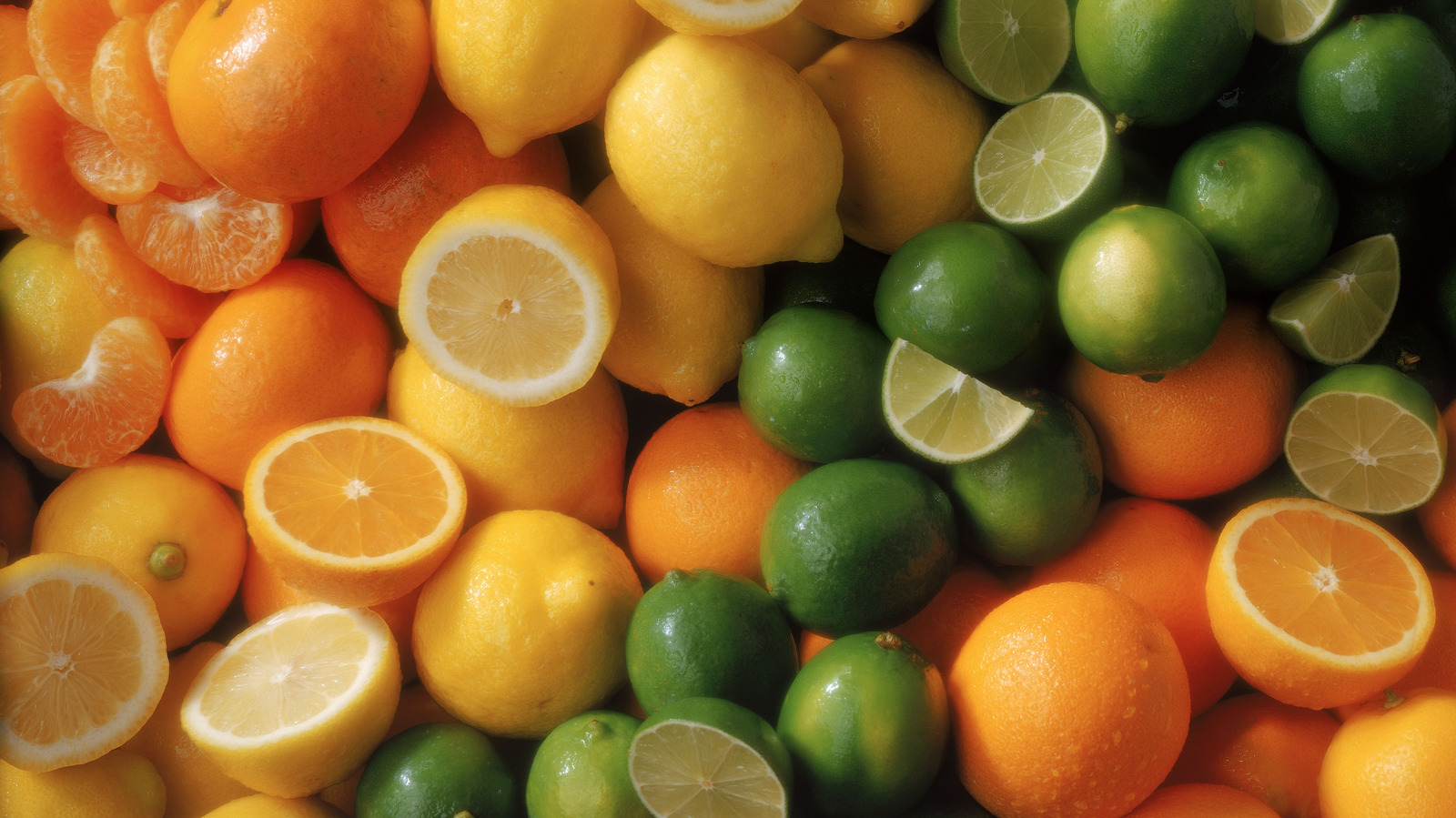The next time you eat an orange or slice up a lime for your margarita, put the citrus peels in your freezer rather than the trash bin. Peels make up approximately 20% of the citrus fruit, so getting rid of them wastes money as well as opportunities to get creative in the kitchen. Although citrus peels in vibrant hues of yellow, green, and orange add pops of color to drinks, they can do so much more than garnish a glass.
The peels contain natural essential oils that can add zesty flavor to a variety of different foods and drinks. Highly aromatic, citrus peels will also infuse your home with a fresh scent. For the best results, freeze your leftover citrus peels in airtight containers until you're ready to use them.

Not only will this technique keep the peels fresher for a longer period, but they'll also be easy to grate into your favorite recipe or cocktail, among many other things. Simply remove the amount of peels that you need, and leave the rest in the freezer for later use. When peeling any type of citrus fruit, such as mandarin oranges, tangerines, Meyer lemons, or , don't press down too hard with the peeler, or you may end up with too much of the bitter-tasting pith attached.
If you're looking for a citrus peeling hack, Also, always thoroughly rinse your citrus before peeling it, as the fruit may be covered in a food-grade wax. Citrus peels are perfect garnishes for cocktails and non-alcoholic drinks Do you want to instantly elevate your cocktail or non-alcoholic drink from boring to bar-worthy? Garnish the beverage with a bit of colorful citrus peel to add both aesthetic appeal and flavor. , as they impart a fresh twist of flavor to martinis, gin and tonics, old fashioneds, negronis, and gimlets, among other types of cocktails.
They also work well perched on the edges of glasses filled with fruity, non-alcoholic punch. Start with ripe, fresh citrus fruit, and use a sharp paring knife or vegetable peeler to remove thin, pith-free strips of peel. Choose fruit with a smooth, vibrantly hued skin for the best taste and appearance.
One way to enhance a cocktail with a peel is by squeezing it over the drink to express the oils, and then dropping it into the glass. You can also bend the peel into a twist as a creative touch, or use a paring knife to make feathered edges for an intricate look. As another fun idea, transform a long strip of citrus peel into a rosette by tightly rolling it up and then sliding it onto a plastic or metal cocktail pick.
Then, balance the pick across the rim of your cocktail or punch glass. If you are feeling extra-fancy, cut the peels into themed shapes, such as hearts on Valentine's Day or clovers on St. Patrick's Day.
Candied peels make delicious sweet treats While homemade candied citrus peels may sound like an intricate, decadent treat reserved for holidays, they're surprisingly easy to make. Not only will making your own sugary peels save you money, they'll also come in handy as healthier candy alternatives for kids. Since you'll be consuming the peels, consider using organic citrus fruit if possible to cut down on unappetizing pesticides and wax.
Even though candied peels are typically made with oranges and lemons, you can also use grapefruits and limes for a unique taste. In addition to eating the candied citrus peels as they are, they're also great incorporated into pies, cakes, and other baked goods recipes, added to granola, and dipped into melted chocolate as a rich treat. To make this nature's candy, simmer 1⁄4 inch-wide peels in a sugar and water mixture for 45 to 60 minutes, or until the liquid turns into a light syrup.
Next, remove the peels from the water using a slotted spoon, and then toss in sugar to coat. Allow the sugary peels to thoroughly dry on a wire rack for up to two days. You can store the candied peels in an airtight container or zipper-seal plastic bag for up to a month in a cool, dry location, or several months in a freezer.
Enjoy the sweet treats yourself, or give them away as holiday and birthday gifts throughout the year. You can use peels to make homemade marmalade Nothing tastes better than sticky, sweet orange marmalade slathered on a piece of buttered toast in the morning. You can up the yum factor a few more notches by making your own marmalade using leftover orange peels.
The good news is that you only need a few extra ingredients and a bit of time and effort to create a jar of the old fashioned preserves. Marmalade is similar to preserves, but it contains peels in addition to fruit, and is made exclusively with citrus. Some recipes call for pectin, but don't worry if you don't have it on hand, as you can make successfully make a jar of delicious marmalade without it.
The citrus fruit naturally contains pectin, which thicken up the marmalade on its own. The first step to creating your own marmalade is cutting orange peels into thin, 1 1⁄2 inch strips, and the fruit into chunks. Soak the ingredients in water overnight to release the pectin and citrus flavor, and then boil for 20 minutes before adding sugar.
Simmer the mixture for an hour or until it is thickened, and then pour it into glass jars and complete the canning process. The citrus oil from the peels will give the spreadable delight a vibrant and intense orange flavor. .
The amount and ratio of ingredients you'll need is dependent on how much marmalade you want to make in one batch. Peels are perfect for making citrus-flavored sugar for dessert and drink toppings Homemade citrus sugar is a fancy way to dress up desserts, drinks such as hot and iced tea, and even steaming bowls of oatmeal for a fresh, vibrant flavor. Just like many other treats containing leftover peels, citrus sugar is simple to make and will become a staple in your household.
You can use any type of citrus fruit, including lemons, limes, and grapefruit, to make this zesty sugar. Each citrusy sugar will bring its own special flavor to the table whenever you need it. Try sprinkling it over frosted cupcakes or sugar cookies to liven up the baked goods, or stir it into a cup of hot cider for a refreshing flavor.
To make this mouthwatering sugar, start by finely grating the citrus peels and allow the zest to dry completely. You can do this by spreading the zest on a parchment paper-lined sheet and placing it in a warm location, such as on a sunny windowsill, for a few days. You can also use your oven set on a low temperature, or a dehydrator, if you have one.
Then, stir your desired amount of zest into a covered jar of sugar, and allow the combination to mix and mingle for a week before using for the fullest flavor. The recommended ratio of citrus zest to sugar is the rind of one large piece of fruit to 2 or 3 cups of the sweet stuff. You can use peels to craft citrus-infused spirits Sure, you can buy citrus-flavored alcohol from the liquor store, but why not infuse your own spirits with leftover peels for an intense rush of flavor? Making your own citrusy spirits at home will allow you to completely customize the taste of your booze, as well as impress friends and family at your next gathering.
Great creative by combining a few different types of citrus peels, such as blood orange and lime, or even herbs and spices, for an unexpected pop of flavor. Making your own citrus-infused spirits is convenient because you can add as little or as much of a zesty pop to your drinks. Enjoy your customized concoction straight-up over ice, or in a variety of different cocktails, including martinis, screwdrivers, and classic Tom Collins.
Begin by selecting the type of spirits you want to infuse. Vodka is a popular choice as it has a neutral taste and will easily absorb the citrus flavor, but you can also use tequila, gin, rum, bourbon, brandy, or anything else you desire. Choose fresh, seasonal produce at the peak of flavor for the most intense infusion, and be sure to remove all pith from the peels to prevent a bitter taste.
Place your desired amount of citrus peels on the bottom of a mason jar, and then fill it up with the selected spirit. Close the jar tightly, and allow the ingredients to steep for at least two to four days before enjoying. Citrus peels can season salt for a zesty flavor Refreshing citrus salt will add a lively burst of flavor to many of your favorite dishes, from fried and grilled seafood to Alfredo sauce.
Roasted vegetables, shrimp tacos, salsa and guacamole, and homemade tortilla chips will benefit from a dash of the citrusy salt. You can also use the bright, flavorful seasons to coat the rim of your margarita glasses on taco night. Any type of citrus peel will work, from sweet heirloom oranges to tart lemons.
For the culinary creatives, blend a few different citrus flavors with your salt, such as Key lime and tangerine. Place the mixture into individual glass bottles, and give them away as gifts for the foodies in your life. The easy process of making citrus salt begins with finely grating citrus peels and then combining your desired amount of zest with sea salt in a bowl.
Next, stir the mixture or rub it gently with your fingers to release the flavorful citrus oil into the salt. Finish by sprinkling the salt over a parchment paper-lined baking sheet, and dry it out in an oven set to 200 F for an hour, or until it is completely free of moisture. You can store jars of citrus salt at room temperature for about three months.
Grated peels will brighten up roasted food Use leftover citrus peels to breathe new life into basic roasted dishes, such as chicken, pork, and vegetables. Use different types of citrus peels to create tailored flavors, such as lime in a Thai or Mexican-inspired recipe. After peeling the citrus, remove all of the white pith and cut the peels into chunks that you can toss into a roasting pan.
You can also chop any desired herbs, including fresh basil, oregano, or cilantro to add to the peels for a customized flavor profile. Mix all of the ingredients in a bowl with olive oil, as well as salt, pepper, and any other seasonings to taste. You can then add the citrusy combination to a roasting pan filled with any type of meat, including chicken breasts or pork chops, and roast all together.
The zesty citrus oil will release from the peels during the roasting process, and infuse the meat with a bright flavor. You can also stuff a whole chicken cavity with the citrus peels as another idea. If you just want the intense citrus flavor, simply grate citrus peels over the top of your meat prior to roasting.
For a vegetarian option, add the citrus peel mixture to a roasting pan of a blend of chopped root vegetables, such as beets and carrots. Peels will give rice a delicate citrus flavor If you're looking for a way to season and brighten up boring white rice without adding sodium or overpowering spices, consider using grated citrus peels. The flavorful zest will infuse the rice with either a delicate or zesty flavor, depending on how much you use.
While you can freshly grate the peel of any citrus fruit of your choice, your stash of frozen rinds will work just fine in the rice. Customize the type of citrus peels you add to the rice according to the dish you're making, such as lime for Thai fried rice, or orange for sweet and sour chicken. There are a few different ways that you can incorporate the citrus peels into your rice.
As one option, add the peels directly to your rice cooker so that the citrus aroma is thoroughly absorbed by the rice. If you're making the culinary staple on the stovetop, stir some citrus zest into the pot of rice and boiling water. You can also just stir the finely grated peels into the cooked rice if you prefer a less intense citrus flavor.
You can infuse oils and vinegars with citrus peels A bottle of citrus-infused oil or vinegar will brighten up any salad, possibly even replacing your favorite store-bought dressing. The beauty of citrusy oil and vinegar is that you can combine the peels with any combination of herbs and even dried florals, such as lavender, to make customized blends. Store the homemade concoctions in pretty glass bottles to decorate your kitchen countertop or give them as thoughtful gifts.
The bottles of citrus-infused oil and vinegar will look especially eye-catching if you add sprigs of dried herbs, such as thyme or rosemary, or edible-grade lavender buds. To create the bottles of goodness, choose your preferred type of oil or vinegar to use as a base. Place the small pieces of citrus peel or zest, as well as any other dry ingredients on the bottoms of the bottles, and then fill to the top with the liquid.
Allow the blends to infuse for up to two weeks and strain the oil or vinegar to remove any solid pieces before using. Peels come in handy for making lemon or orange extract for baked good Homemade lemon and orange extract will give your baked goods a rich, bakery shop-worthy flavor. All that is required to make the intensely flavored extract is some leftover citrus peels and a few ounces of a clear, flavorless spirit with a high proof, such as vodka.
The alcohol will absorb all of the citrusy flavor of the peels, and become your go-to ingredient for recipes such as lemony pound cake, lemon chiffon pie, lemon poppy seed muffins, and zucchini bread. If orange-flavored desserts are more of your thing, use handmade extract to enhance cranberry-orange tiramisu, orange-pistachio divinity, and an orange ricotta cake roll. To make the extract, simply fill a glass jar with the peel of three pieces of citrus fruit and 3 ounces of alcohol.
Cover the jar tightly and allow the ingredients to steep in a cool, dark location, such as a pantry, for a few months to create an intense flavor. Strain the alcohol and throw away the peels before using the extract. You can transform peels into oleo-saccharum If you have a mason jar, discarded citrus peels, and plenty of sugar, you have everything you need to make your own oleo-saccharum, which is Latin for "oil-sugar.
" Oleo-saccharum is an age-old recipe that dates back to the 17th century and has been used to flavor cocktails with an heady citrus flavor ever since. When packed together, the large amount of sugar can extract both the moisture and essential oil from the citrus peels, resulting in an concentrated citrus-flavored syrup. Use the sweet and zesty syrup to flavor your favorite cocktails and punches.
All you have to do to make this time-tested treat at home is layer any type of citrus peels with sugar, alternating the two up to the top. Cover the jar with an airtight lid and then place in your refrigerator overnight. The citrusy, sugary infusion is then ready to liven up your favorite drinks and even desserts.
Try drizzling the syrup over vanilla ice cream, pancakes, or waffles as a refreshing touch. Recommended.
Food

11 Reasons To Stop Throwing Away Citrus Peels

Waste not, want not, right? Stop throwing away those citrus peels, and here's why. After all, they can be used for much more than just cocktail decoration.















